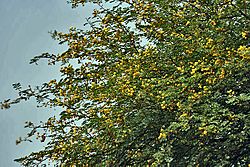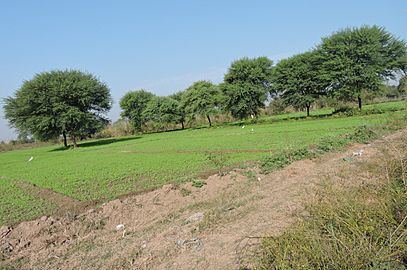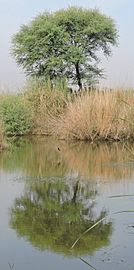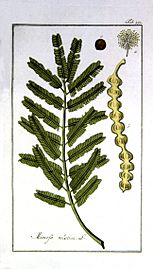Vachellia nilotica facts for kids
Quick facts for kids Vachellia nilotica |
|
|---|---|
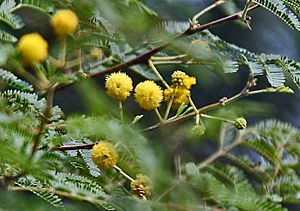 |
|
| Scientific classification | |
| Genus: |
Vachellia
|
| Species: |
nilotica
|
| Subspecies | |
|
|
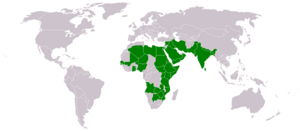 |
|
| Range of Vachellia nilotica | |
| Synonyms | |
|
|
Vachellia nilotica, also known as Acacia nilotica, is a fascinating flowering tree. People call it by many names, like gum arabic tree, babul, or thorny acacia. It belongs to the pea family, Fabaceae. This tree naturally grows in parts of Africa, the Middle East, and the Indian subcontinent. However, in places like Australia and the United States, it's considered an invasive plant. This means it can spread quickly and harm local plants and ecosystems.
Contents
Tree Names and Classification
This tree was once the main example for the plant group called Acacia. The name Acacia comes from an old Greek word, akakía. An ancient Greek doctor named Pedanius Dioscorides used this name for the tree because it had medicinal uses.
Why the Name Changed
For a long time, scientists knew that the Acacia group included many different types of trees. These trees were not all closely related. So, in 2005, a group of plant experts decided to change the names. The name Acacia was kept for trees mostly found in Australia. Our tree, A. nilotica, was moved to a new group called Vachellia. This change was a bit controversial, especially in Africa, where people still often call it an acacia.
Meaning of the Names
The name Acacia comes from the Greek word ákis, which means "thorn". This makes sense because many of these trees have thorns. The second part of the name, nilotica, was likely given by Carl Linnaeus. He probably named it after the Nile River, where this tree was first known to grow. In Australia, it's sometimes called "prickly acacia" even though Australian Acacia trees usually don't have thorns.
What the Tree Looks Like
The Vachellia nilotica tree can grow quite tall, from about 5 to 20 meters (16 to 65 feet) high. It has a thick, round top, like a ball. The trunk and branches are usually dark or black and have cracked bark. If you cut into the bark, a reddish, sticky gum might come out.
Thorns and Leaves
Young trees have thin, straight, light grey thorns. These thorns grow in pairs, usually 3 to 12 pairs, and can be 5 to 7.5 centimeters (2 to 3 inches) long. Older trees often don't have thorns. The leaves are made up of many tiny leaflets, like a feather. Each leaf has 3 to 6 pairs of branches, and each branch has 10 to 30 pairs of small leaflets.
Flowers and Pods
The flowers are bright golden-yellow and grow in round clusters. Each cluster is about 1.2 to 1.5 centimeters (half an inch) wide. They grow on stalks at the ends of the branches. After the flowers, the tree produces pods. These pods are hairy, white-grey, and thick. They are squeezed tightly between each seed. Each kilogram of pods holds about 8,000 seeds.
Where the Tree Grows
Vachellia nilotica is originally from many parts of the world. It grows naturally from Egypt, across North Africa (the Maghreb and Sahel regions), and south to places like Mozambique and KwaZulu-Natal, South Africa. It also grows east through the Arabian Peninsula to the Indian subcontinent and Myanmar. This tree has also spread and grown in new places, like Zanzibar and Australia. It often spreads when animals eat its pods and carry the seeds to new areas.
Uses of the Tree
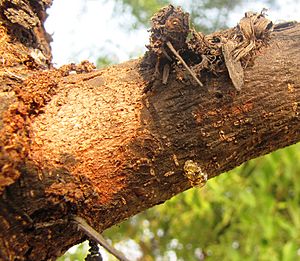
Food for Animals
In some areas, small animals like sheep and goats eat the pods and leaves of this tree. It's also very popular with cattle. In India, the pods are sometimes added to chicken feed. Animals grazing in fields especially look for the dried pods. Farmers in India also cut branches to feed their livestock. In West Africa, people believe the pods and leaves can help small animals get rid of worms.
Natural Toothbrush
In parts of Southeast Africa and the Indian subcontinent, people use the soft, young twigs of this plant as a natural toothbrush.
Gum Arabic
The sticky gum that comes out of this tree is known as gum arabic. People have collected this gum since ancient Egyptian times. They used it to make medicines, dyes, and paints. Today, the gum arabic you find in stores usually comes from other types of Acacia or Vachellia trees. However, the gum from Vachellia nilotica is also used, especially in India, where it's called Amaravati gum.
Strong Wood
The wood from this tree is very strong and lasts a long time, especially if it's treated with water. It's used to make tool handles and wood for building boats. The wood is quite heavy, weighing about 833 kilograms per cubic meter.
Food and Traditional Medicine
In India, parts of the tree are used as an ingredient in different dishes. The Maasai people in Africa eat the inner bark and the fruit pulp after boiling them in water. They also use this plant in traditional medicine to help with sore throats, coughs, and chest pains. In Northern Nigeria, where it's called bagaruwa, people soak the soft bark in water to help with stomach problems. The fruits and seeds are ground up and mixed with honey to help with stomach ulcers.
How the Tree Spreads
The tree spreads by its seeds. There are a lot of seeds in each kilogram of pods, usually between 5,000 and 16,000 seeds.
Gallery
See also
 In Spanish: Acacia nilotica para niños
In Spanish: Acacia nilotica para niños


